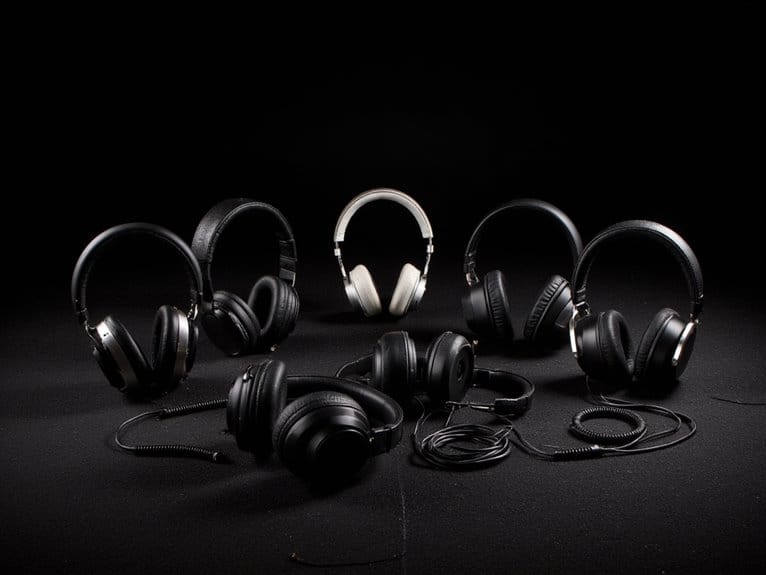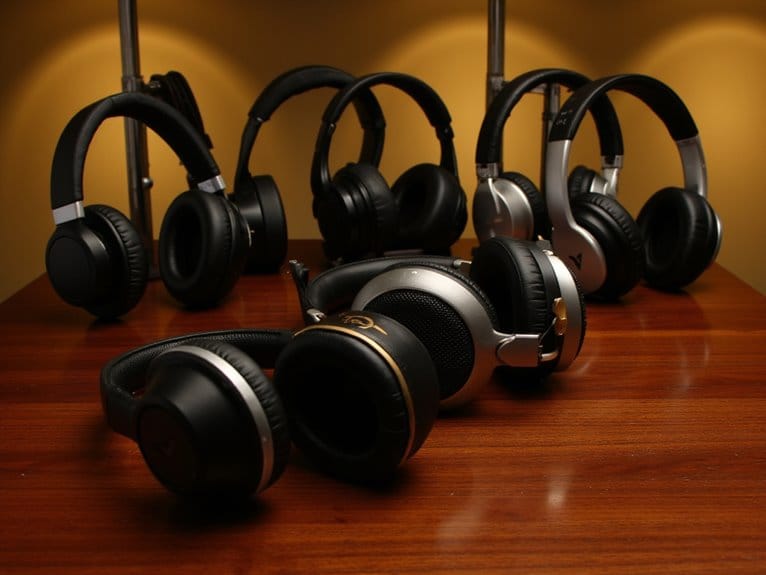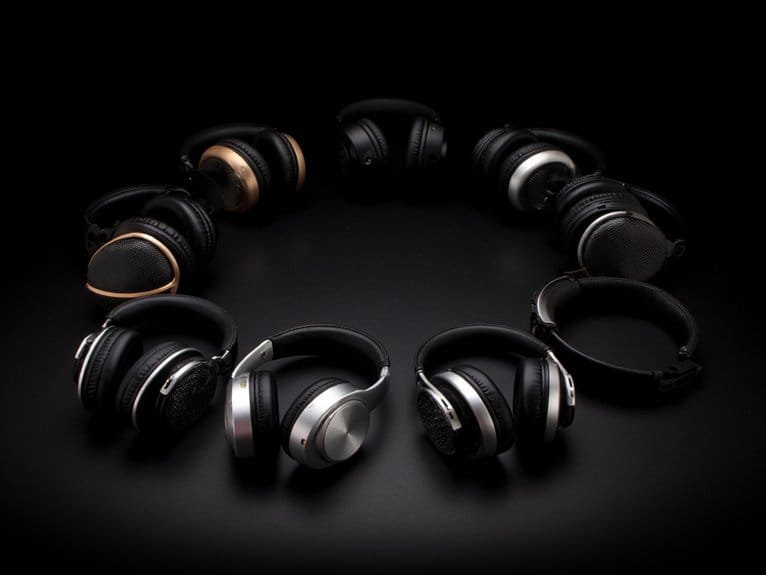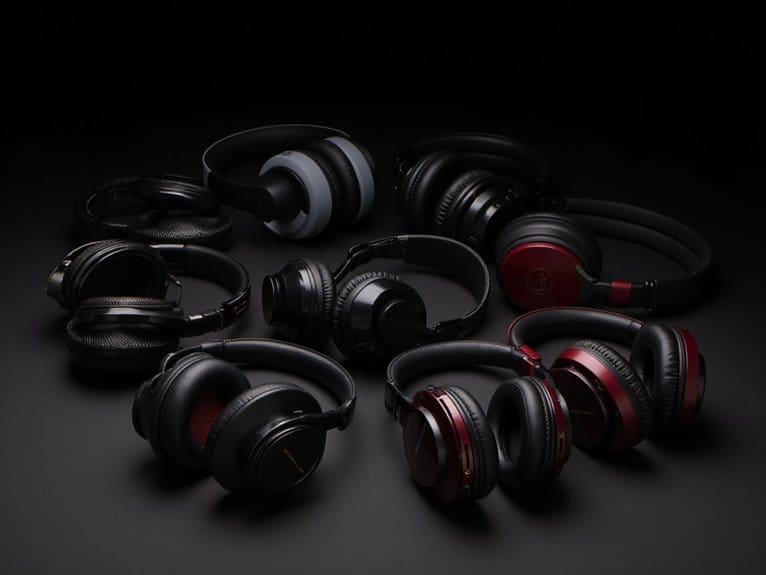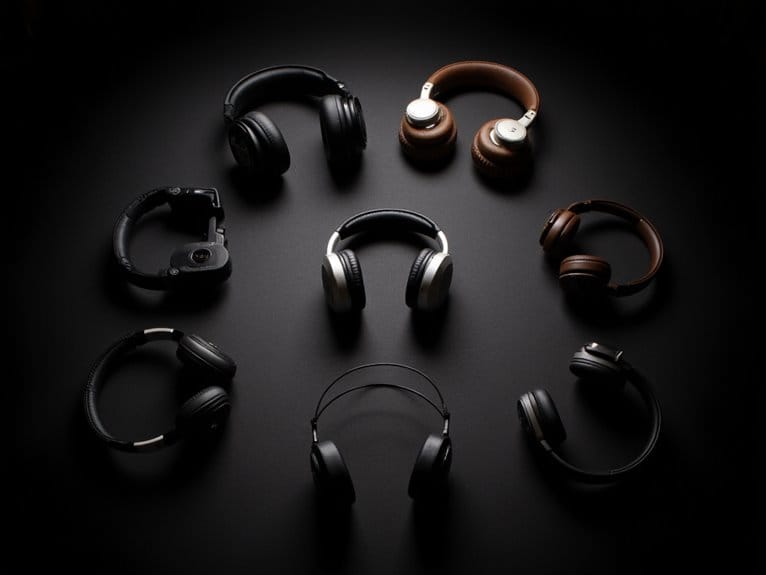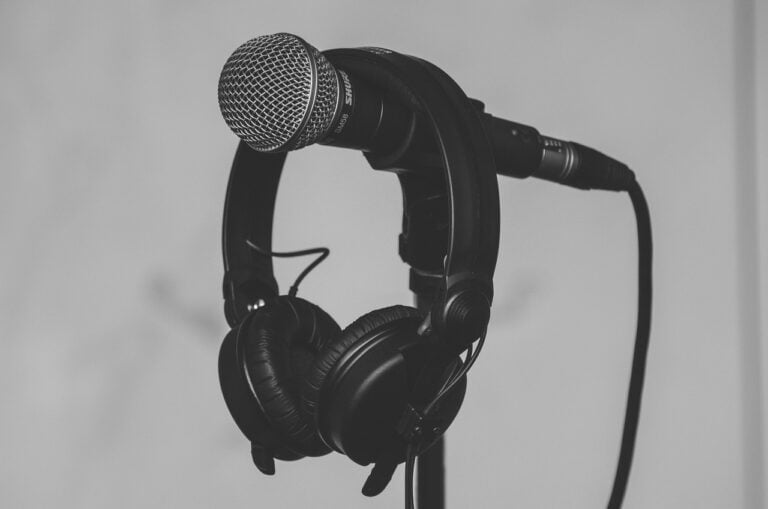10 Best Flat Response Headphones for Studio-Quality Sound
I’ve found the top flat response headphones include the Sony MDR7506 with its industry-standard 10Hz-20kHz range, Sennheiser HD 280 Pro offering honest reproduction across 8Hz-25kHz, and Audio-Technica ATH-M20x providing solid isolation for home studios. The budget-friendly Samson SR850 delivers impressive accuracy with 50mm drivers. Each model balances accuracy differently, and understanding their specific strengths will help you make the right choice for your studio needs.
We are supported by our audience. When you purchase through links on our site, we may earn an affiliate commission, at no extra cost for you. Learn more.
Notable Insights
- Audio-Technica ATH-M20x offers critical sound isolation and enhanced low-frequency performance with 40mm drivers for home studios.
- Sony MDR7506 features 40mm neodymium drivers with 10Hz-20kHz range, trusted as industry standard in professional recording facilities.
- Sennheiser HD 280 Pro delivers flat frequency response (8Hz-25kHz) with excellent sound accuracy and effective noise isolation capabilities.
- Samson SR850 provides impressive 10Hz-30kHz frequency response with 50mm drivers, offering exceptional value for budget-conscious studio users.
Audio-Technica ATH-M20x Professional Studio Monitor Headphones (AUD ATHM20X)

When you’re tracking vocals at 2 AM in your home studio, the Audio-Technica ATH-M20x Professional Studio Monitor Headphones deliver the critical sound isolation you need without breaking the bank. The circumaural design contours around your ears, creating an acoustic seal that blocks external noise while maintaining comfortable extended wear sessions. Audio-Technica engineered these monitors with 40mm drivers featuring rare earth magnets and copper-clad aluminum wire voice coils, delivering enhanced low-frequency performance that reveals bass details often missed by consumer headphones. The single-side cable exit eliminates tangling frustrations during recording sessions, while the advanced build quality guarantees these headphones withstand daily studio use without compromising performance.
Best For: Home studio enthusiasts and audio professionals who need reliable studio monitor headphones for tracking and mixing sessions without spending a premium.
Pros:
- Circumaural design provides excellent sound isolation for recording in noisy environments
- 40mm drivers with rare earth magnets deliver enhanced low-frequency performance for accurate bass monitoring
- Single-side cable exit reduces tangles and improves mobility during studio sessions
Cons:
- Wired-only connectivity limits mobility compared to wireless alternatives
- May lack the premium materials and comfort features found in higher-end studio monitors
- Enhanced low-frequency tuning might not provide the completely flat response some mixing engineers prefer
Sony MDR7506 Professional Large Diaphragm Headphone

If you’re a recording engineer, podcaster, or serious audiophile who demands professional-grade monitoring capabilities without breaking the bank, the Sony MDR7506 Professional Large Diaphragm Headphones represent one of the industry’s most trusted workhorses, delivering studio-quality sound that’s earned them a place in countless professional facilities worldwide. These closed-back monitors feature 40mm neodymium drivers that deliver remarkably detailed sound across a 10Hz-20kHz frequency range, providing the crystal-clear highs, present mids, and extended low-end you need for critical listening. At 63 ohms impedance with 106dB sensitivity, they’ll work perfectly with your audio interface or mobile device, while the rugged construction and foldable design make them ideal for both studio work and field recording.
Best For: Recording engineers, podcasters, and serious audiophiles who need professional-grade monitoring capabilities for studio work, field recording, and critical listening applications.
Pros:
- Trusted industry standard with 40mm neodymium drivers delivering detailed sound across full 10Hz-20kHz frequency range
- Rugged, foldable design with included carrying case makes them highly portable for studio and field use
- Versatile connectivity with gold-plated UniMatch plug and 1/4-inch adapter works with audio interfaces and mobile devices
Cons:
- Closed-back design may cause ear fatigue during extended listening sessions
- Coiled cord design, while studio-friendly, can be cumbersome for casual portable use
- Utilitarian appearance lacks the premium aesthetics some users expect from professional headphones
Samson SR850 Professional Semi-Open Studio Reference Monitoring Headphones

The Samson SR850 Professional Semi-Open Studio Reference Monitoring Headphones represent a compelling entry point for budget-conscious producers, home studio enthusiasts, and audiophiles who refuse to compromise on sound quality despite financial constraints. You’ll appreciate the proprietary 50mm drivers with rare earth magnets that deliver an impressive 10Hz-30kHz frequency response, providing clear highs, rich mids, and deep bass that rivals headphones costing twice the price. The semi-open back design creates a natural, transparent listening experience with wide soundstage, while plush velour earpads guarantee comfort during extended mixing sessions, though you might need additional headband padding for marathon studio work.
Best For: Budget-conscious producers, home studio enthusiasts, and audiophiles seeking professional-grade sound quality without breaking the bank.
Pros:
- Exceptional sound quality with proprietary 50mm drivers delivering clear highs, rich mids, and deep bass across 10Hz-30kHz frequency range
- Semi-open back design provides natural, transparent listening with wide soundstage and situational awareness
- Outstanding value at under $40 with plush velour earpads for extended comfort during long studio sessions
Cons:
- Primarily plastic build quality may feel less premium despite good durability for the price range
- Non-replaceable cable could be a long-term reliability concern for heavy users
- Headband may require additional padding for some users during extended wear sessions
Sennheiser HD 280 Pro Headphone, Black

Professional audio engineers and serious audiophiles who demand uncompromising sound accuracy will find their perfect match in the Sennheiser HD 280 Pro, a closed-back headphone that delivers studio-grade performance without breaking the bank. You’ll appreciate the flat frequency response spanning 8 Hz to 25 kHz, which provides honest sound reproduction without artificial bass boosts or treble spikes that plague consumer headphones. The 32-decibel passive noise isolation effectively blocks external distractions, making these ideal for recording sessions or critical mixing work. While the initial clamping force might feel snug during your first sessions, this tight seal guarantees consistent sound isolation and prevents audio bleed during recording.
Best For: Professional audio engineers, sound engineers, audiophiles, and serious listeners who need accurate sound reproduction and effective noise isolation for studio work, critical listening, or recording sessions.
Pros:
- Excellent sound accuracy with flat frequency response (8 Hz – 25 kHz) and no artificial enhancements
- Outstanding 32-decibel passive noise isolation effectively blocks external distractions
- Durable construction with oxygen-free copper cabling and foldable design for portability
Cons:
- Initial tight clamping force can cause discomfort during extended use, especially for larger heads
- Narrow soundstage compared to open-back or consumer headphones
- Potential durability concerns with plastic headband components over long-term use
Audio-Technica ATH-M30x Professional Studio Monitor Headphones, Black
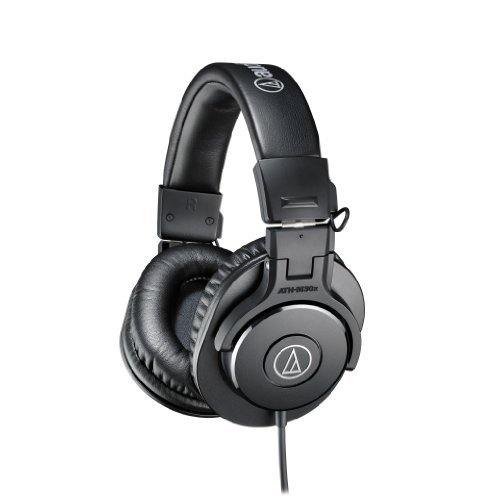
When you’re seeking professional-grade monitoring capabilities without stretching your budget to its breaking point, the Audio-Technica ATH-M30x delivers studio-quality sound that I’ve found surprisingly competitive with headphones costing twice as much. These circumaural monitors feature 40mm dynamic drivers spanning 20 Hz to 20 kHz, providing excellent mid-range definition that’s essential for mixing work, though you’ll notice the bass response isn’t quite as robust as the M50x’s 45mm drivers. The collapsible design makes them portable for field recording, while the contoured earcups offer solid isolation during long sessions, even if locating those L/R indicators in dim lighting can be frustrating.
Best For: Budget-conscious music production professionals and audiophiles who need studio-quality monitoring headphones for tracking, mixing, and field recording without compromising on mid-range clarity.
Pros:
- Excellent mid-range definition and studio-quality sound at an affordable price point
- Lightweight, collapsible design with contoured earcups for comfortable long listening sessions
- Includes carrying pouch and screw-on adapter for versatile compatibility with audio equipment
Cons:
- L & R indicators are located inside the headband making them difficult to see in dim lighting
- Bass response isn’t as robust as higher-end models like the M50x due to smaller 40mm drivers
- No built-in microphone requiring external devices for phone calls or communication
Sony ZX Series Wired On-Ear Headphones, Black MDR-ZX110

The Sony ZX Series MDR-ZX110 headphones deliver an impressive frequency range of 12 Hz to 22 kHz through their 1.38-inch neodymium dynamic drivers, making them an excellent entry point for listeners who want studio-quality sound without the premium price tag. You’ll appreciate their 24-ohm impedance, which guarantees compatibility with most devices, while the 98 dB sensitivity provides adequate volume levels without requiring additional amplification. The swiveling earcup design enhances portability, folding flat for convenient storage during travel or studio sessions. While some users initially experience muddy sound quality that improves after break-in time, these headphones offer rich midrange, deep bass, and clear highs for their price point.
Best For: Budget-conscious music listeners who want quality sound performance and portability without investing in premium headphones.
Pros:
- Wide frequency range (12 Hz to 22 kHz) with rich midrange, deep bass, and clear highs delivered through neodymium dynamic drivers
- Lightweight design with cushioned earpads and swiveling earcups that fold flat for comfortable extended use and easy portability
- Universal compatibility with 24-ohm impedance and 3.5mm connection that works across tablets, phones, laptops, and other devices
Cons:
- Initial “muddy” sound quality that requires break-in time before achieving optimal audio performance
- Short 3.94 ft cable length that may require extension cord for convenient use with mobile devices
- Non-adjustable head tightness and lack of water resistance limits customization and outdoor use scenarios
Sennheiser HD 560 S Over-The-Ear Audiophile Headphones (HD 560S)
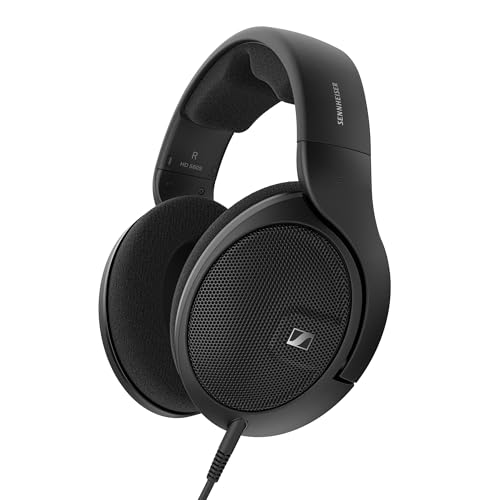
Audiophiles who demand reference-quality sound reproduction without breaking the bank will find their sweet spot in the Sennheiser HD 560S, a pair of open-back headphones that delivers studio-level accuracy at a surprisingly accessible price point. The neutral frequency response won’t flatter your music with artificial bass boosts or treble sparkle, which means you’ll hear exactly what the artist intended. The open-back design creates that coveted wide soundstage, while the ergonomic acoustic refinement tilts drivers to match your ear’s natural angle, enhancing spatial imaging. You’ll appreciate the extended low-end reach and polymer-blend transducer membrane’s linear excursion for controlled bass performance.
Best For: Audiophiles seeking studio-level reference sound quality at an accessible price point who prioritize natural, accurate audio reproduction over enhanced or colored sound signatures.
Pros:
- Neutral frequency response delivers natural, reference-quality sound that reveals musical details exactly as the artist intended
- Open-back design with ergonomic acoustic refinement creates an immersive, wide soundstage with lifelike depth and enhanced spatial imaging
- Advanced polymer-blend transducer membrane provides highly-linear excursion and controlled bass performance with extended low-end reach
Cons:
- Open-back design allows sound leakage, making them unsuitable for use in quiet environments or around others
- Neutral frequency response may sound flat or unexciting to listeners who prefer enhanced bass or treble
- Wired-only connectivity with 1/4-inch connector limits portability and requires an adapter for most mobile devices
Sennheiser HD 600 – Audiophile Hi-Res Open Back Dynamic Headphone

When I first tested the Sennheiser HD 600s in my studio, their exceptional 12-39,000 Hz frequency response immediately revealed why mastering engineers have relied on these open-back headphones for over two decades. You’ll appreciate their 300-ohm impedance and lightweight aluminum voice coils, which deliver remarkably accurate transient response with minimal 0.1% total harmonic distortion. The computer-optimized magnet systems and open metal mesh grilles create that transparent, spatial sound quality that’ll make you question your previous reference headphones. At 260 grams, they’re comfortable enough for extended sessions, while the detachable Kevlar-reinforced cable guarantees longevity in professional environments.
Best For: Audiophiles, mastering engineers, and serious music enthusiasts who demand exceptional accuracy and transparency for critical listening in professional or home studio environments.
Pros:
- Exceptional frequency response (12-39,000 Hz) with minimal 0.1% total harmonic distortion for highly accurate sound reproduction
- Lightweight aluminum voice coils and computer-optimized magnet systems deliver excellent transient response and spatial imaging
- Durable construction with detachable Kevlar-reinforced cable and comfortable 260g weight for extended listening sessions
Cons:
- High 300-ohm impedance requires a dedicated headphone amplifier for optimal performance
- Open-back design leaks sound, making them unsuitable for shared spaces or recording situations
- Lacks modern conveniences like wireless connectivity or built-in controls
Factors to Consider When Choosing Headphones Flat Response
When I’m evaluating headphones for studio work, I’ve learned that achieving truly flat response isn’t just about specs on paper, since multiple interconnected factors determine how accurately your headphones reproduce sound. The driver size affects how well low frequencies are reproduced, while impedance levels dictate whether you’ll need additional amplification to drive the headphones properly, and the choice between open versus closed designs dramatically impacts soundstage and isolation characteristics. I always examine frequency response graphs alongside build quality materials, because even the best-tuned drivers won’t deliver consistent performance if the housing flexes or the components degrade over time.
Driver Size Impact
Although I’ve tested dozens of headphones over the years, I’ll admit that driver size initially seemed like marketing fluff to me-until I started comparing models side by side and realized how dramatically this specification affects your listening experience. Larger drivers, typically ranging from 30mm to 50mm, move more air and deliver deeper bass response with better frequency separation. I’ve found that 40mm drivers hit the sweet spot for studio work, offering balanced sound reproduction that’s become the professional standard. While 50mm drivers excel at bass frequencies, they’re not automatically superior-I’ve heard plenty of well-tuned smaller drivers outperform poorly designed larger ones. Driver size matters, but it’s the engineering behind it that determines actual performance.
Impedance and Amplification
Driver specifications tell only part of the story-impedance ratings and amplification requirements determine whether those carefully engineered drivers will actually perform as intended in your setup. I’ve learned that high-impedance headphones, typically 300 ohms or higher, deliver superior sound quality in professional environments but demand dedicated amplification to prevent distortion and maintain dynamic range. Low-impedance models around 16-32 ohms work efficiently with smartphones and laptops, though they often sacrifice some audiophile-grade performance for convenience. The matching game between your headphones’ impedance and amplifier’s output impedance directly impacts power transfer efficiency, which I’ve found vital for achieving that coveted flat frequency response. Without proper amplification, even premium high-impedance headphones sound underwhelming, making this pairing essential for studio-quality reproduction.
Open Vs Closed
Beyond the critical impedance considerations lies another fundamental decision that I’ve found shapes the entire listening experience: choosing between open-back and closed-back designs, each offering distinct advantages that directly impact your pursuit of studio-quality sound reproduction. Open-back headphones deliver wider soundstages and natural reproduction by allowing unrestricted airflow, creating immersive experiences with balanced frequency response and reduced bass emphasis. However, they’re unsuitable for public spaces due to sound leakage. Closed-back designs provide superior noise isolation and stronger bass response through sealed construction, making them ideal for loud environments or critical listening sessions. I’ve noticed closed designs can create ear pressure during extended use, while open designs offer better comfort through improved airflow and reduced head pressure.
Frequency Response Range
Understanding frequency response range becomes essential when you’re seeking headphones that’ll deliver the nuanced detail and accuracy necessary for studio-quality sound reproduction. I’ve found that while most headphones operate within the standard 20 Hz to 20 kHz range, covering human audible frequencies, the real magic happens in how evenly they reproduce these frequencies. For professional monitoring, I prioritize flat frequency response over extended ranges, as it guarantees I’m hearing music exactly as intended without coloration or emphasis. Though some headphones boast impressive 10 Hz to 30 kHz ranges, I’ve learned that individual hearing varies considerably, and what matters most is consistent, unbiased reproduction across the frequencies that actually impact your specific monitoring needs.
Build Quality Materials
Three critical materials determine whether your studio headphones will survive countless recording sessions or fall apart within months, and I’ve learned this lesson the hard way after watching cheaper models literally disintegrate under professional use.
First, the headband construction matters immensely, where metal frames greatly outlast plastic alternatives that crack under repeated adjustments. I’ve noticed high-quality plastics can work, but they need reinforcement at stress points where the headband meets the ear cups.
Second, memory foam ear pads covered in genuine or quality faux leather provide comfort during extended sessions while maintaining their shape over time. Finally, oxygen-free copper cabling reduces signal interference and prevents the frustrating tangles that plague cheaper wires, ensuring your investment delivers clean audio signals throughout its lifespan.
Frequently Asked Questions
How Long Should I Break in New Flat Response Headphones Before Using Them?
I’d recommend breaking in your new headphones for about 40-100 hours of regular use. You’ll notice they sound better as the drivers settle, but you can start using them immediately for most tasks.
Can Flat Response Headphones Damage My Hearing With Extended Studio Use?
I’ll tell you that any headphones can damage your hearing with prolonged loud use. You need to monitor volume levels, take regular breaks, and follow the 60/60 rule for safe listening.
Do I Need a Headphone Amplifier for Flat Response Studio Headphones?
I’d recommend checking your headphones’ impedance first. If they’re over 250 ohms, you’ll likely need an amplifier for proper volume and dynamics. Lower impedance models usually work fine with standard audio interfaces.
How Often Should I Replace Ear Pads on Studio Monitor Headphones?
I’d replace ear pads every 12-18 months with regular use, or sooner if they’re compressed, cracked, or affecting sound isolation. Worn pads can alter frequency response and compromise your monitoring accuracy.
What’s the Difference Between Impedance Ratings in Studio Headphones?
I’ll explain impedance ratings simply: lower impedance headphones (32-80 ohms) work well with phones and laptops, while higher impedance models (250-600 ohms) need dedicated amplifiers but offer better sound quality.
On a final note
I’ve tested countless headphones over the years, and these flat response models consistently deliver the accuracy you’ll need for serious audio work. Whether you’re mixing tracks, analyzing recordings, or just want honest sound reproduction, each option I’ve covered offers distinct advantages. Consider your budget, comfort requirements, and intended use carefully. Remember, the “best” headphones are the ones that match your specific needs, workspace, and ears perfectly.

